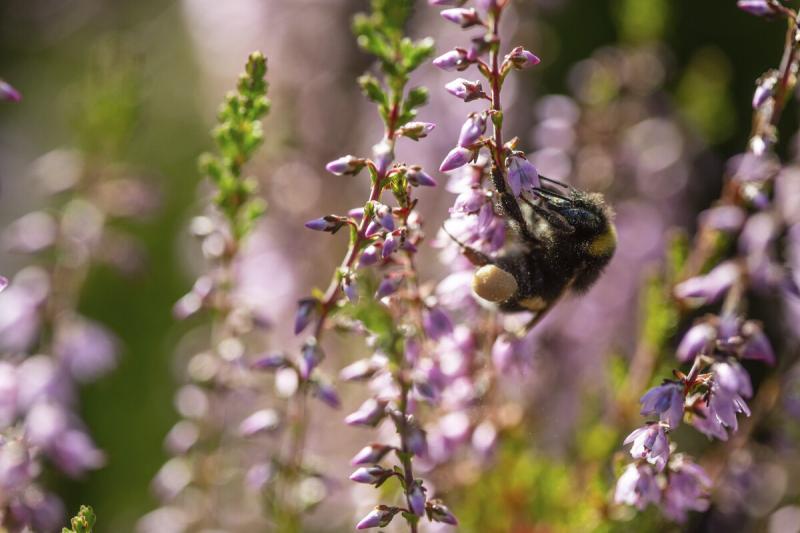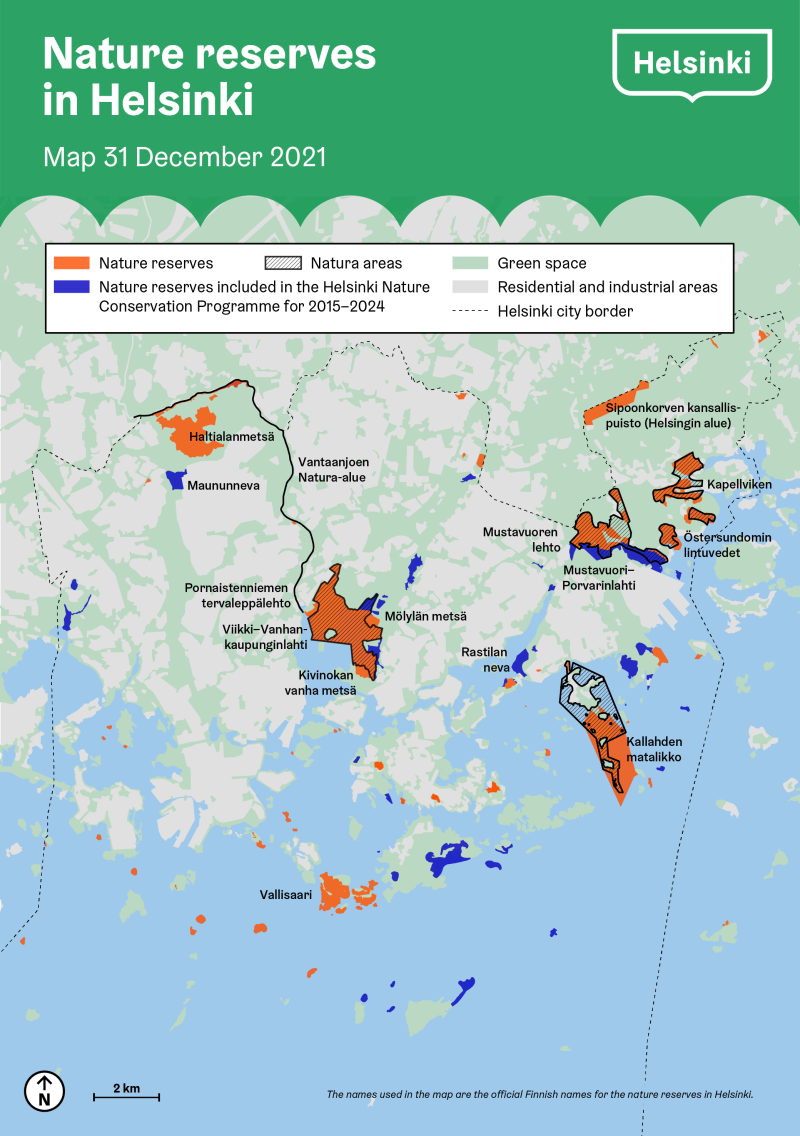Securing biodiversity
In autumn 2021, a new City Strategy for 2021–2025, A Place of Growth, was decided on. The Strategy aims at sustainable growth in harmony with ecological boundaries. Essential elements regarding biodiversity are green areas and the Baltic Sea. The City of Helsinki Biodiversity Action Plan 2021–2028 (LUMO) was finally completed after a long preparation period, and subsequentially approved by the Environment Committee. A key objective of the LUMO plan is to take biodiversity into consideration in all operations of the City. In 2021, as many as 63 LUMO actions, equalling 66%, were launched, some of which involve continuous development.
The Nature Monitoring Plan and new information about biodiversity
The Environmental Services prepared a Nature Monitoring Plan in 2021. The plan mainly includes the monitoring of species and biotopes. Some of the monitoring processes are based on location data, but many of them require an inventory on-site. Some of the new monitoring processes will begin in 2022.
Of the longer-term monitoring processes, the bird monitoring in Vanhankaupunginlahti Bay and the archipelago continued in 2021. The monitoring of bumblebees continued for the third year in a row. The number of tree bumblebee and gypsy cuckoo bumblebee specimens was significantly higher than in past years. However, there were much fewer large red-tailed bumblebees. The honeybee was also having another weak year.
In 2021, extensive information about the biodiversity of underwater nature was collected from the sea area off the coast Helsinki. The survey was carried out as a part of the national programme on surveying underwater biodiversity (VELMU). The preliminary results of the survey were published as a map layer on the City’s internal map service which shows the most valuable areas for underwater biodiversity. The results will be elaborated on and refined during 2022.
Information from the endangered and near-threatened biotopes in Helsinki surveyed in 2017–2020 has been compiled in the Helsinki Nature Information System (LTJ). The survey was carried out on the mainland and on 45 islands. Occurrences of endangered biotopes covered 450 hectares, while near-threatened ones covered 100 hectares. They exist fairly evenly around the Helsinki, apart from the most densely-built areas. The most endangered biotopes are semi-natural biotopes and swamps and many groves. The sites identified in the survey were divided into three value classes based on their conservation status and the diversity of the location. The most valuable class includes sites with endangered biotopes with an excellent or good level of diversity. There were a total of 390 such sites in the materials collected.
In summer 2021, decaying wood in Helsinki forests was inventoried. The results of the inventory will be used to assess the amount of decaying wood in various urban forests. Changes caused by storms and insects in forests are being constantly monitored in connection with other maintenance work. A separate monitoring project is also underway, involving the Urban Environment Division, the Natural Resources Institute Finland (LUKE) and the University of Helsinki.

Biodiversity to be increased in green area planning and maintenance
In 2021, the survey of meadow networks was completed, the work on blue networks began, and the flying squirrel network was updated to improve critical points.
During the year, 42 detailed plans were prepared, in 21 of which the green factor was used and nature-related provisions were set based on the factor. Ecological networks were taken into consideration in the detailed plans, with the exception of three plans. Conflicts between the green network and other land use remained in these plans. A total of 23 detailed plans included provisions on the implementation of green roofs. Furthermore, the ‘Fifth Dimension’ project of the University of Helsinki in Kurkimoisio studies green roofs as habitats for endangered species. Provisions on green roofs were included in two detailed plans. In updates to the detailed plans, the spots for small water bodies, open swamps and spring mires were marked as green areas or local green areas and areas to be preserved. The restoration plan for the eastern fork of the Vanhankaupunginkoski Rapids were completed.
Decaying wood was left in the forests subject to maintenance, trees of varying ages were favoured, and forest areas were excluded from maintenance work. In 2021, the area plan for Oulunkylä and Maunula and the public area plans for Herttoniemi and Vuosaari, as well as Malmi and Pukinmäki, were completed. All of these plans promote biodiversity in both forests and meadows. The recently completed meadow network survey was taken into consideration in the plans.
The updated species planning guidelines included in the urban flora guide paid attention to insects’ and birds’ requirements on habitats and nutrition. The section on plants in the urban space instructions was also updated. It now includes e.g. new instructions on layered greenery on streets. The maintenance of lawns was changed so that they were only mowed once in summer 2021. In addition to this, a total of ten parks were selected in the OmaStadi project to have more meadow-like lawns through changes to the maintenance methods.
The Maintenance Department updated the product cards on work instructions to direct the City of Helsinki construction services (Stara) and subcontractors. The instructions also include guidelines on biodiversity. Product cards for recycled substrates were also prepared regarding the recycling of soil and handling soil that includes invasive alien species.
Invasive alien species were combatted in green areas in connection with other management measures, through voluntary work events and in cooperation with residents, educational institutions, organisations and open prisons. The City received funding from the Ministry of Agriculture and Forestry to combat the rugosa rose on the bird islets in the archipelago and the shores in Mustikkamaa and Lauttasaari. The project will last three years. The monitoring of Himalayan balsam in the Mätäjoki River catchment area, carried out together with the City of Vantaa, also received government funding. The area has plenty of Himalayan balsam. Hogweed populations are monitored and combatted, as necessary. The aim is to exterminate hogweed from Helsinki entirely. All invasive alien plant species were also combatted in worksites in conjunction with the construction of Jokeri Light Rail.
State funding for nature conservation
The proportion of nature reserves from the all land area increased by 0.6% in a year. At the moment, the proportion is at 3.8%. The proportion of nature reserve of all water area also increased by 0.5%, currently being at 0.98%. When including protected biotopes, species protection areas, and Natura areas not protected by the Nature Conservation Act, the total protected area amounts to 4.4% of Helsinki’s land area and 1.5% of water areas. The new proposed nature reserves will increase the percentage of protected land area to 5.8%.
The Centre for Economic Development, Transport and the Environment (ELY Centre) founded three new nature reserves in Helsinki, all of which are bird islets: Pitkäouri, Tiirakari and Ulko-Hattu. The latter was founded at the suggestion of the Lauttasaari Society. The Finnish Government founded two nature reserves in its land located in the Helsinki area: Vallisaari and Kapellviken. Founding applications and maintenance and usage plans were completed for five sites included in the nature conservation programme. These sites include Kruunuvuorenlampi, which is the only protected pond in Helsinki, the diverse Uutela forest area, the Rudträsk wetlands and the impressive Skatanniemi scenic cliff with its antiquities.
Extensive grazing of cattle started in Bruksviken by the Östersundom bird waters. A pasture was built and a restoration action plan was prepared for it in cooperation with the Lumovoimaa project of Metsähallitus. Through the project, grazing animals were also found for the area. As soon as the first summer, the number of birds in Bruksviken increased significantly, and birdwatchers consider it to be one of the best bird bay in Helsinki, along with Vanhankaupunginlahti. An extension to the pasture was introduced to the bird waters in Vanhankaupunginlahti, which will expand the area where the cattle graze by a third from the previous pasture. In the bird waters of both Östersundom and Vanhankaupunginlahti, reed fields were mowed by using the funding from the Ministry of the Environment’s Helmi project.
Investments in nature were made in the Mustavuori and Östersundom area regarding the sites included in the nature conservation programme and their vicinity. Three new Class I and two new Class II polypore and Corticium sites were delineated for the area. The inventories revealed several endangered or near-threatened species and species that were new to science. In the survey on the cap-and-stem mushrooms that mainly grow on the ground in lime-heavy areas, two endangered species were discovered, and the insect survey resulted in several specimens of the Siberian winterdamsel, which is strictly protected under Appendix IV of the nature directive. Biotopes were defined and endangered plant species were discovered in the areas. The results of the nature surveys will be used when planning the maintenance and use.
In 2021, the Ministry of the Environment granted funding from the Helmi programme to the restoration of the Haltialanmetsä swamp groves and the Bengtsår oak groves and semi-natural biotopes. These are endangered biotopes. In Haltiala, the previously launched restoration of the swamp grove will be expanded and enhanced. Invasive alien species were removed from Haltiala, dams were built for drains, and the monitoring of the restoration progress was started. In Bengtsår, the vegetation of the oak grove, including tree saplings, have suffered from roe deer grazing in the area and maples shading the oaks. Because of this, fences were set up for the grove and roe repellents were spread to protect the saplings of the valuable broad-leaved trees. Additionally, maples were removed from around old oaks. In the nature reserve, the pines planted into the grove were thinned out for the vegetation to revert to the original grove.
In the ‘Stay on the Trail’ campaign and the ‘Responsible Forest Adventure’ materials directed at young people instructed people on sustainable outdoor recreation in nature reserves and green areas.
The preparation of the City’s nature service policy started. The policy will direct and develop the recreational use of nature and secure the health benefits provided by nature.

Korkeasaari Zoo Wildlife Hospital is Finland’s largest institution for caring for wild animals
The Wildlife Hospital of Korkeasaari Zoo received 1,290 animals for treatment and care in 2021. The number of patients was lower than in the previous year, during which 1,700 animals were brought into care. The number of patients was affected by a northern goshawk that was brought into care in February 2021 and was diagnosed to be carrying avian influenza. Because of this, veterinary authorities ordered the hospital facilities to be closed down for two months and disinfected. Even after the hospital reopened, the practical care work involved many precautions. Due to the risk of avian influenza, certain bird species were not accepted for care, or accepted only limitedly. Of birds delivered to care, the swift was the most common, and the most common mammal was the squirrel. Rarer animals brought into care included a kingfisher, a common murre, a ruff, a white-backed woodpecker, a greater white-fronted goose, a Brandt’s bat, a brown long-eared bat and a common toad. An exceptional number of northern bats, 17 specimens, were looked after. Three grey seal pups were in care. Of animals brought into care, about 40% survived and could be returned to the wild.
Eyes on the future
The excellent progress towards securing biodiversity will continue, and nature will be better included in all of the City’s operations. For this purpose, information and instructions regarding species and biotopes will be added to so that the rarest species and habitats can be secured. This also involves the determined development of green and blue networks. The recreational opportunities in nature will be promoted, but the wear on nature will be prevented, at the same time.
